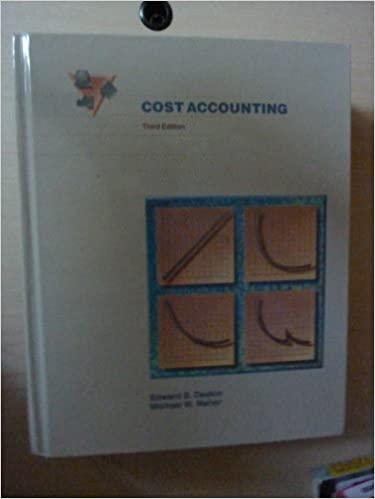Comprehensive Differential Costing Problem: Hospital Supply, Inc., produced hydraulic hoists that were used by hospitals to move
Question:
Comprehensive Differential Costing Problem: Hospital Supply, Inc., produced hydraulic hoists that were used by hospitals to move bedridden patients. The costs of manufacturing and marketing hydraulic hoists at the company's normal volume of 3.000 units per month are shown in Exhibit A Required: Unless otherwise stated, assume there is no connection between the situations described in the questions; each is to be treated independently. Unless otherwise stated, a regular selling price of $740 per unit should be assumed. Ignore income taxes and other costs that are not mentioned in Exhibit A or in a question itself.
a. What is the break-even volume in units'? In sales-dollars?
b. Market research estimates that volume could be increased to 3,500 units, which is well within hoist production capacity limitations, if the price were cut from $740 to $650 per unit. Assuming the cost behavior patterns implied by the data in Exhibit A are correct, would you recommend that this action be taken? What would be the impact on monthly sales, costs, and income?
c. On March l. a contract offer is made to Hospital Supply by the federal govern- ment to supply 500 units to Veterans Administration hospitals for delivery by March 3 1 . Because of an unusually large number of rush orders from their regular customers, Hospital Supply plans to produce 4,000 units during March, which will use all available capacity. If the government order is accepted, 500 units normally sold to regular customers would be lost to a competitor. The contract given by the government would reimburse the government's share of March manufacturing costs, plus pay a fixed fee (profit) of $50,000. (There would be no variable marketing costs incurred on the government's units.) What impact would accepting the government contract have on March income?
d. Hospital Supply has an opportunity to enter a foreign market in which price competition is keen. An attraction of the foreign market is that demand there is greatest when demand in the domestic market is quite low; thus idle production facilities could be used without affecting domestic business. An order for l .000 units is being sought at a below-normal price in order to enter this market. Shipping costs for this order will amount to $75 per unit, while total costs of obtaining the contract (marketing costs) will be $4,000. No other

variable marketing costs would be required on this order. Domestic business would be unaffected by this order. What is the minimum unit price Hospital Supply should consider for this order of 1.000 units'?
e. An inventory of 230 units of an obsolete model of the hoist remains in the stockroom. These must be sold through regular channels (thus incurring variable marketing costs) at reduced prices, or the inventory will soon be valueless. What is the minimum price that would be acceptable in selling these units?
f. A proposal is received from an outside contractor who will make and ship 1.000 hydraulic hoist units per month directly to Hospital Supply's customers as orders are received from Hospital Supply's sales force. Hospital Supply's fixed market- ing costs would be unaffected, but its variable marketing costs would be cut by 20 percent for these 1,000 units produced by the contractor. Hospital Supply's plant would operate at two thirds of its normal level, and total fixed manufacturing costs would be cut by 30 percent. What in-house unit cost should be used to compare with the quotation received from the supplier? Should the proposal be accepted for a price (that is, payment to the contractor) of $425 per unit?
g. Assume the same facts as above in requirement
(f) except that the idle facilities would be used to produce 800 modified hydraulic hoists per month for use in hospital operating rooms. These modified hoists could be sold for $900 each. while the costs of production would be $550 per unit variable manufacturing expense. Variable marketing costs would be $100 per unit. Fixed marketing and manufacturing costs would be unchanged whether the original 3.000 regular hoists were manufactured or the mix of 2,000 regular hoists plus 800 modified hoists were produced. What is the maximum purchase price per unit that Hospi- tal Supply should be willing to pay the outside contractor? Should the proposal be accepted for a price of $425 per unit to the contractor?
Step by Step Answer:






